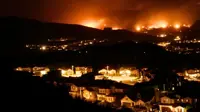Exploring the fate of the Earth's storehouse of carbon
02 Dec 2016
Soil and climate expert Katherine Todd-Brown, a scientist at the Department of Energy's Pacific Northwest National Laboratory, is an author of the paper, published in the Dec. 1 issue of the journal Nature, which draws upon data collected through 49 separate field experiments around the world.
The research was led by Thomas Crowther, formerly of Yale and now at the Netherlands Institute of Ecology, and colleague Mark Bradford at Yale. Scientists from more than 30 institutions across the globe, including PNNL, collaborated on the study.
Soil is a huge reservoir of carbon - more carbon is stored underfoot than in the foliage above. This is especially true in the world's coldest places, where slow microbial activity has helped keep the carbon locked away.
But the fate of carbon in soil has been an open question for scientists. Many past studies have indicated that as temperatures rise, more carbon will be released from the soil into the air. But other findings suggest that this release of carbon could be balanced by other activity. For instance, plants will thrive more fully in some regions, sucking more carbon dioxide out of the air and into those plants and surrounding soil.
The direction of this exchange - from soil to air, or from air to plants and soil - and the rate are central to our planet's future. When carbon dioxide is in the atmosphere it acts as a greenhouse gas, warming the planet, but in the soil it has less influence on climate.
To address the question, the team pulled together data from more than four dozen previous experiments from across North American, Europe and Asia - an "amazing data set," according to Todd-Brown, that included direct measurements of the actual amounts of carbon in the soil. Each experiment included information on the amount of carbon that remained in soil as the land was warmed, compared to "control" plots of plants that were not warmed.
The team found that the rate of exchange between soil and air in these field studies varies depending on the temperature change, length of the study, and amount of carbon in the soil originally. Overall, the team noted that a large increase in the transfer of carbon from the soil to the atmosphere is possible, supporting previous conclusions from lab experiments.
With warming temperatures and increased microbial activity, the researchers believe the transfer of carbon from the soil to the atmosphere will quicken, happening fastest in the world's colder regions where soil carbon stocks are the highest and warming is expected to be greater. Whether this carbon would be offset by plants taking up more carbon is an open question, but the authors believe this is unlikely.
"This is the first large-scale study to see a change in the carbon stock in soil directly due to field warming experiments. Typically soil carbon measurements are too imprecise to see a direct warming effect but by looking at so many studies we were able to detect a trend," said Todd-Brown. "It's crucial information because carbon in soil is one of the largest sources of carbon dioxide on the planet."
Todd-Brown said that the exact amount of carbon released depends on a number of other factors not analyzed in the study. These include shifts in land use, changes in soil moisture and precipitation, the complex chemistry of carbon in soil, microbial activity in deeper soils, and accelerated plant growth.
Todd-Brown played a key role in the study, performing much of the statistical analysis of data collected over 20 years at multiple sites. The work, aimed at developing mathematical equations that represent and explain how much carbon is released from the soil under warming conditions, was central to the paper.
"Soil is one of the most interesting systems on the planet to model," said Todd-Brown. "There's a fascinating mix of phenomena at work - complex surfaces, fluid dynamics, microbial interactions, nutrient cycling. It's very complicated and wonderfully challenging to think about how to capture all that action."
Todd-Brown's contribution to the study was funded by PNNL through its Laboratory Directed Research and Development program and its Linus Pauling Distinguished Fellowship program.



.webp)
.webp)

.webp)
.webp)

























